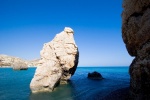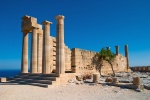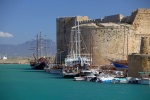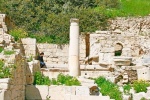History of Cyprus
History of Cyprus. Situated at the maritime crossroads of the eastern Mediterranean basin, Cyprus has a rich and varied history. During the 12th and 11th centuries B.C. Achaean Greeks come to settle on the island bringing with them the Greek language, their religion and their customs. They build new cities like Paphos, Salamis, Kition.

History of Cyprus
The 8th century B.C. is a period of great prosperity but the island falls prey to several conquerors. Cypriot Kingdoms try to preserve their independence but come under the domination of Assyria and then Egypt and Persia. King Evagoras of Salamis (who ruled from 411-374 BC) rebels against Persia and unifies the island but, after a great siege has to conclude peace with Persia and loses control of the whole island.
In 333 BC Alexander the Great defeats Persia and Cyprus becomes part of his empire. After Alexander's death Cyprus comes under the Hellenistic state of the Ptolemies of Egypt, and belongs from now onwards to the Greek Alexandrine world. The capital is now Paphos. This is a period of wealth for Cyprus.
In 358 BC Cyprus becomes part of the Roman Empire. During the missionary journeys by Saints Paul and Barnabas, Cyprus becomes the first country to be governed by Christian. Destructive earthquakes occur during the 1st century B.C. and the 1at A.D. and cities are rebuilt.
After the division of the Roman Empire in two parts 330 A.D., Cyprus comes under the Hellenic empire of Byzantium known as Eastern Roman Empire, with Constantinople as its capital.
Constantine the Great's mother, Helena is said to have stopped in Cyprus on her journey from the Holy Land, with remnants of the Holy Cross and founded the monastery of Stavrovouni. More earthquakes during the 4th century A.D. completely destroy the main cities. Cities lose their splendour and remain in ruins.
New cities arise, Constantia is now the capital, and large basilicas are built as from the 4-5th century A.D. In 647 Arabs invade the island. In 688 Emperor Justinian II and Caliph al-Malik sign a treaty neutralizing Cyprus, but violations are reported, and the island is also attacked by pirates until 965 when Emperor Nicephoros Phocas expels Arabs from Asia Minor and Cyprus.
In 1192 Cyprus is ruled by Frank Guy de Lusignan. Many beautiful gothic buildings belong to this period including the Cathedrals of Ayia Sophia in Nicosia, Saint Nicholas in Famagusta and Bellapais Abbey. Nicosia becomes the capital of Cyprus and the seat of the Lusignan Kings. The Lusignan dynasty ends when the last queen Catherina Cornaro cedes Cyprus to Venice in 1489.
Venetians see Cyprus as a last bastion against the Ottomans in the east Mediterranean, and fortify the island tearing down lovely buildings in Nicosia to bring the city into a tight encircled area defended by bastions and a moat which can still be seen today. They also build impressive walls around Famagusta which were considered at the time as works of military art.
In 1570 troops attack Cyprus, capture Nicosia, and slaughter the population (20,000) and lay siege to Famagusta for a year. After a brave defence by Venetian commander Marc Antonio Bragadin, Famagusta capitulates to the Ottoman commander Lala Mustafa, who first gives free passage to the besieged but when he sees how few they are, orders the flaying, drawing and quartering of Bragadin and puts the others to death.
On annexation to the Ottoman Empire, the Latin hierarchy are expelled or converted to Islam and the Greek Orthodox faith restored; in time, the Archibishop as leader of the Greek Orthodox becomes their representative to the Porte. When the Greek War of Independence breaks out in 1821, the Archibishop of Cyprus, Kyprianos, three bishops and hundreds of civic leaders are executed.
In 1878 Britain assumes administration of the island, which remains formally part of the Ottoman Empire until 1914 when Britain annexes Cyprus, after the Ottoman Empire enters the First World War on the side of Germany. In 1923 under the Treaty of Lausanne, Turkey renounces any claim to Cyprus. In 1925 Cyprus is declared a Crown colony. In 1940 Cypriot volunteers serve in various branches of the British Armed Forces throughout the Second World War. Hopes for self-determination now being granted to other countries in the post-war period are shattered by the British who consider the island vitally strategic. An Armed Liberation Struggle, after all means of peaceful settling of the problem are exhausted, breaks out in 1955 which last until 1959.
According to the Zurich-London Treaty, Cyprus becomes an independent republic on 16th August 1960. It is a member of the United Nations, the Council of Europe and the Commonwealth as well as the Non-Aligned Movement. According to the above Treaty, Britain retains in the island two Sovereign Bases, (158.5 sq km) at Dhekelia and Akrotiri-Episkopi.
The 1960 Constitution of the Cyprus Republic proves unworkable in many of its provisions, and this made impossible its smooth implementation. In 1963, the Turkish ministers withdrew from the Cabinet and the Turkish civil servants ceased attending their offices while Turkey threatened to invade Cyprus. Ever since then, the aim of the Turkish Cypriot leadership, acting on instructions from the Turkish Government, has been the partitioning of Cyprus and annexation by Turkey.
In July 1974, a coup is staged in Cyprus by the Military junta, then in power in Athens, for the overthrow of President Makarios. On 20 July 1974, Turkey launched an invasion with 40,000 troops against defenceless Cyprus. Since 1974, 37% of the island is under Turkish military occupation and 200,000 Greek Cypriots, 40% of the total Greek Cypriot population, were forced to leave their homes in the occupied area and were turned into refugees.
The invasion of Turkey and the occupation of 37% of the island's territory as well as the continuing violation of the fundamental human rights of the people of Cyprus have been condemned by international bodies, such as the UN General Assembly, the Non-aligned Movement, the Commonwealth and the Council of Europe.
The only country to formally recognise The "Turkish Republic of Northern Cyprus" is Turkey. Turkey has repeatedly violated numerous UN Resolutions and refers to the Republic of Cyprus as the "Greek Cypriot Administration of Southern Cyprus".
After the southern, Greek speaking part of Cyprus became a member of the European Union, it adopted the Euro as its currency on January 1, 2008, replacing the previously used Cypriot Pound; whilst the northern area continued to use the Turkish Lira and on January 1, 2008 the New Turkish Lira.
History of Cyprus.Cyprus entered the EU in 2004.











